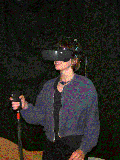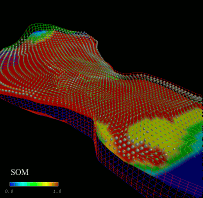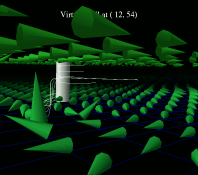3. Current Abstract
The goal of this project is commercially available and supported software which
implements techniques for visualizing flux data as well as advanced
user interfaces, commonly called Virtual Reality (VR), for use
by engineers in the oil industry.
To date, the project has been successful overall, as the major highlight
of the past few months has been a commercial release of software which
implements some of the visualization techniques resulting from our effort.
Visualization of flux is important to the oil industry, as estimates of
unswept oil in US reservoirs is approximately 90 billion barrels, the
fiscal value of which is roughly the same as the current national debt.
Reservoir engineers make extensive use of software simulators to evaluate
production strategies. One type of data computed by such simulators is
"flux" data which indicates the direction and quantity of fluid movement
through the reservoir for oil, gas, water and other phases. At the time
this project was proposed, there existed no commercially available software,
from a U.S. company, which could be used to visualize flux data.
Current budget woes have resulted definitive negative impact on project
progress. The original proposal called for a two-year funding profile.
Only 80% of the requested FY 1995 funds were received, and presently
it looks like there will be no FY 1996 funding. The scope of this impact
will be more fully discussed below.
Despite the lack of FY 1996 funding, the PI on this project has been
able to produce tangible results which broadly meet the goals of the
project.
4. Progress Last Six Months
- Magnetic Trackers and Headgear brought online.
- Prototype device-driver code was written which decodes multiplexed
packets from the peripherals controller to which multiple Polhemus trackers
are connected. This code produces delta-x, -y, and -z translational changes,
as well as delta-azimuth, -elevation and -roll changes, and performs
flawlessly.
- Integration of new devices into our laboratory visualization environment.
- These devices can be used to control viewer location within the virtual
world, as well as to control the position and orientation of the objects in
the virtual world. Some of these objects, such as
a virtual well, can be used to control computational processes, such
as computing instantaneous velocity through a flow field (commonly called
streamlines).

An Earth Scientist from LBNL using the VR display and input devices to
explore data.
- Developed a new visualization technique which identifies area of
low oil flux, but high oil saturation. These readily-identified areas
help the reservoir engineer quickly find unswept areas in the reservoir,
based upon the relationship between two dependant variables.

- Demonstrated Integrated VR and Visualization Capabilities to the Public.
- We demonstrated our work to the public at Supercomputing 95, held in
San Diego CA during December 1995. At the LBNL booth, we had a high-powered
graphics computer running our visualization software. The purpose of the
demonstration was to allow persons to gain first-hand experience using
the VR devices.

- Western Atlas Software releases Commercial version of flux visualization software.
- Alpha versions of Western's commercial product, 3DView, was delivered
to users in late January 1996. The highlight of this release was the first
implementation of a flux visualization technique identified early in this
project. The first customer shipment of this software is scheduled for
31 March 1996. The beta version of this software is presently in use
at BP sites in Anchorage and Houston.
- The Memorandum of Understanding for this project has been agreed-to
and signed by all parties.
5. Plans for Next Six Months
- Release Freely Available VR Software.
- As part of this project, we plan to make available, via anonymous ftp,
our software for implementing VR. The software can presently be used only
within a particular visualization environment, the Application Visualization
System (AVS), which is widely used at LBNL for prototyping visualization
algorithms.
- Implement VR Technology in the field.
- The PI on this project will travel to a field site and work closely
with reservoir engineers to bring VR input technology to the field.
This approach will produce positive results, as the engineers will
gain a full appreciation of how VR technology can be used in exploring
reservoirs, and will create a demand for this type of technology.
- Port VR software to Khoros
- The original project proposal calls for Khoros-versions of
the VR and visualization software. Khoros is a freely-available
visualization software environment.
- Present Technical Paper
- A paper has been submitted, for peer review, to a meeting on
"VR in the Geosciences."
With the completion of these tasks, our obligations in this project
will be complete.
6. Project Percent Complete
The project is approximately two-thirds complete.
7. Project Schedule Completion Date
Given the above milestones and assuming that funding for this program
will not materialize, we will conclude our actitivies by the end of FY 1996.
8. Major Highlights/Accomplishments
- Commercialization of the product.
- Western Atlas Software, one of the industry participants, has released
for commercial sale its own visualization software which implements some
of the basic techniques for flux visualization. This is a significant
milestone, as producing such software is one of the major goals of this
project.
- Pilot commercial operation.
- This software has been in use at BP locations since January 1996.
Feedback from users is positive.
9. Current Industry Partner Contacts
Andy Austin, Mark Lederer - BP Exploration
(713) 560-8205, FAX: (713) 560-6318
Todd Little - Western Atlas Software
(713) 972-4666, FAX: (713) 972-4647
10. Funding needed for FY 97 (Multi-Year CRADAs)
This project is scheduled for completion at the end of FY 1996.




